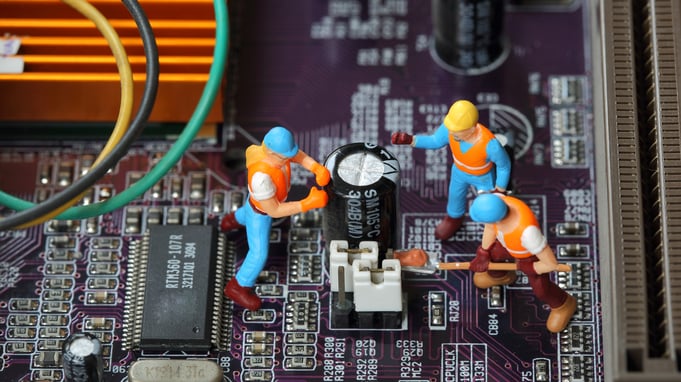
Getting ready to invest in a media server? Take your time, because choosing the right solution for your application requires careful thought and consideration. And before you do anything, you need to tackle the central issue: should you build your own media server or opt for a pro off-the-shelf unit? In this blog post, we take a look at some of the key factors to keep in mind before making the final call.
- What is a media server?
- Who offers solutions for self-build media servers?
- Who offers solutions for prebuilt media servers?
- Do you have the hardware and software skills necessary to build your own media server?
- What about support, service and warranty?
- Do you have a license to re-sell Microsoft products?
- What about longevity & 24/7 use?
- What about CE, FCC and other standards?
What is a media server?
There are probably as many definitions of “media server” as there are readers of this blog. My definition of a media server is a computer-based server, that allows you to manage, compose and playback all the different media elements in your show (video, still images, animations, graphics, live feeds, sound) on multiple displays. Preferably perfectly synchronized, at high resolution, and right-on-cue. And it allows full integration with external units or devices.
There are a number of media server software/hardware providers in the market. One of the oldest, if not the oldest, WATCHOUT from Dataton was released in 2000, with new ones arriving on the market now and then. Other products and/or manufacturers include Catalyst, Arkaos, Disguise, Green Hippo, Christie, Ventuz, AV Stumpfl, VDMX, Resolume, Millumin, Analog Way, 7th Sense Design, Madmapper, Playback Pro, QLab, Modulo-Pi, for example. Check out the PLSN media server survey for more info.
Some of these products offer a broad feature-set and performance capabilities which means they can be used in a range of applications. Others offer a more limited range of features geared towards a specific niche, or high-end features only requested by a select few customers and markets (and with a price tag to match).
Who offers solutions for self-builD media servers?
Dataton (WATCHOUT), Millumin, Resolume, Madmapper, Avolites Ai, Catalyst, Christie Digital (Pandoras Box), Arkaos, AV Stumpfl (Pixera), QLab, VDMX are among the companies that offer a solution where you can cherry-pick your own components, build a sturdy media server, then install and run the software. All run on Windows operating system, with the exception of Catalyst, QLab, VDMX and PlaybackPro as they are designed for Mac, meaning you have to use pre-configured Mac-hardware.
Most of these companies (such as Dataton) offer a free-for-download version of the media server software, but you need to acquire a license to be able to use it IRL.
Who offers solutions for prebuilt media servers?
Dataton, Arkaos, Disguise, Green Hippo, Christie Digital (Pandoras Box), Ventuz, AV Stumpfl, Analog Way, 7th Sense Design, VYV, Avolites Ai and Modulo-Pi are some of the manufacturers that offer prebuilt media-servers. The price point ranges from below USD 5,000 to USD 100,000 and above – depending on performance and add-ons. There are also many reputable third-party suppliers of prebuilt media servers for specific brands and applications.
The prebuilt media-servers have one thing in common: they come with a locked-down operating system, ensuring that the media server will function for the specific design purpose – and nothing else.
Do you have the hardware and software skills to build your own media server?
The availability of high-performance PC components has never been better with new and improved hardware released frequently. In general, building a high performance, top quality and reliable media server requires a combination of well-honed skills to select the right hardware, to tune the BIOS settings and tweak the Microsoft Windows® 10 operating system.
Even if you are an avid gamer and have successfully built high-performance gaming machines, or you are a seasoned builder of personal workstations and such, creating a full-fledged media server does require more from you. Make sure you have access to the right skills to fully understand and utilize the hardware.
When it comes to BIOS settings, firmware adjustments, and not to mention the operating system itself, you have a tedious test task ahead of you to make sure you tweak all parts of the operating system for peak performance. You will need to be thoroughly up-to-speed on these key questions:
- Install Windows and select which features to add and remove
- How to handle updates? No updates?
- What about hibernation files and OneDrive?
- How do you handle group policies?
- Which drivers work well together and which don’t? A new version of a GPU driver might cause problems, while the previous version doesn’t
- How to address services, registry settings and task scheduler needs
There are plenty of things to consider regarding hardware, too. How many cores should my CPU have? Can I overclock or not? (you should not!) How many PCI-lanes should my motherboard have? Can I use a dual CPU system? Can I use two GPUs? How much memory do I need? What kind of hard drives? Should I RAID the disks? If I use the fastest SSD drives, what benefits would I have for RAID?
What about support, service and warranty?
If you purchase a prebuilt, locked-down media server, the developer knows the exact hardware configuration and can easily recreate – and fix – any challenges you may have with your system. The operating system and drivers will also be locked down and will undergo rigorous testing before a new version of the software is released. If a new GPU driver is released, you do not need to think about it – if it increases performance, it will make it to a later release of the system. If it doesn’t increase performance? Well, at least you did not spend a week testing it before finding that out.
If you build your own server and install media software, the developer will have limited possibilities to supply qualified support. They don’t know your hardware and its settings, nor how the operating system is set up and tweaked. That makes it nigh on impossible to fully re-create any issues you may have and thus provide a satisfactory answer to your support question.
If you decide to build your own, make sure that the software developer has a big install base and a large community that can help you if you run into problems – I can guarantee you that there will be challenges.
Most off-the-shelf consumer products have a one-year warranty whereas some industrial or professional-grade components have a two or three-year warranty. When buying a prebuilt media server, you will often have the option of extending the warranty up to five years with access to service and support.
Do you have a license to re-sell Microsoft products?
If you are building your own media servers for commercial use and sale, make sure that you have the rights to resell Microsoft Windows®. I recommend that you get hooked up with Microsoft directly before you do so, to make sure you are on the right side of the law before you start reselling.
What about longevity & 24/7 use?
Many installations with media servers involve long operating hours, some even running round-the-clock. Consumer-grade products are simply not built for this kind of use. Hardware that’s manufactured to run 24/7 or 14 to 18 hours per day generally follows a different approach in the design and the choice of subcomponents. And so the price tag goes up and the number of users with experience from building servers with the components goes down – perhaps not an ideal combination.
What about CE, FCC, CCC and other standards?
In various markets, such as Europe, China and USA, there are set requirements for products being sold into the market. In Europe, CE marking shows that the products conform with safety, health, and environmental requirements. This declaration entails certain costs, of course, for relevant testing and manufacturing procedures. Potential customers would require that the media servers meet these kinds of standards.
Conclusion
If you want to build your own media server, that’s great! But make sure that you have what it takes when it comes to both hardware and software skills.






